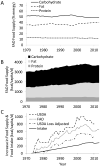Did the Food Environment Cause the Obesity Epidemic?
- PMID: 29265772
- PMCID: PMC5769871
- DOI: 10.1002/oby.22073
Did the Food Environment Cause the Obesity Epidemic?
Abstract
Several putative explanations of the obesity epidemic relate to the changing food environment. Individual dietary macronutrients have each been theorized to be the prime culprit for population obesity, but these explanations are unlikely. Rather, obesity probably resulted from changes in the caloric quantity and quality of the food supply in concert with an industrialized food system that produced and marketed convenient, highly processed foods from cheap agricultural inputs. Such foods often contain high amounts of salt, sugar, fat, and flavor additives and are engineered to have supernormal appetitive properties driving increased consumption. Ubiquitous access to convenient and inexpensive food also changed normative eating behavior, with more people snacking, eating in restaurants, and spending less time preparing meals at home. While such changes in the food environment provide a likely explanation of the obesity epidemic, definitive scientific demonstration is hindered by the difficulty in experimentally isolating and manipulating important variables at the population level.
Published 2017. This article is a U.S. Government work and is in the public domain in the USA.
Figures

References
-
- Simpson SJ, Raubenheimer D. Obesity: the protein leverage hypothesis. Obes Rev. 2005;6:133–142. - PubMed
-
- Martens EA, Lemmens SG, Westerterp-Plantenga MS. Protein leverage affects energy intake of high-protein diets in humans. Am J Clin Nutr. 2013;97:86–93. - PubMed
-
- Martens EA, Tan SY, Dunlop MV, Mattes RD, Westerterp-Plantenga MS. Protein leverage effects of beef protein on energy intake in humans. Am J Clin Nutr. 2014;99:1397–1406. - PubMed
-
- Bray GA, Popkin BM. Dietary fat intake does affect obesity! Am J Clin Nutr. 1998;68:1157–1173. - PubMed
MeSH terms
Grants and funding
LinkOut - more resources
Full Text Sources
Other Literature Sources
Medical

